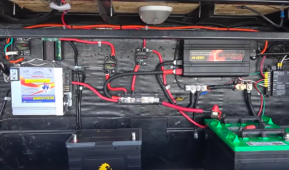dixonge
New Member
- Joined
- Jun 18, 2021
- Messages
- 190
I'm trying to do some cleanup on my RV electrical system, and I feel like I need a nice summary of how to use bus bars. Right when I think I understand, I see some diagram or photo that makes it look like power is just going to be running back and forth all over the place, instead of in a more linear path. I see all the negative lines go to a bus bar, then one going to ground. So are negative common bus bars the same as ground bars? I've also seen charge controllers, batteries and inverters all connected to a positive bus bar. So how do you prevent voltage coming from the solar panels from just jumping straight over to the inverter, bypassing the batteries altogether?
A bit confused here...(see photo below, for example)

A bit confused here...(see photo below, for example)



